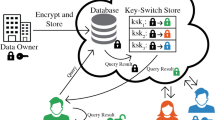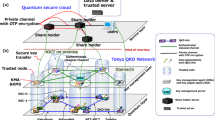Abstract
Very few organizations can afford the necessary infrastructure for genomic data analytic, which requires a very large amount of storage and computational resources. In this context, cloud computing platforms can be adopted as a practical solution for storage and computations. However, sharing such sensitive information with cloud providers can lead to violating privacy preservation and public regulations. To resolve this problem, homomorphic encryption (HE) can be used. Homomorphic encryption enables computation over encrypted data, which helps tackling the problem of privacy preservation. Despite this advantage, existing HE schemes suffer from high computational complexity and storage overhead; designing a practical HE scheme that provides simultaneously the efficiency and the required level of security still remains an open question. In this paper, we propose a secure cloud based scheme for storing and analyzing classified genetic data using homomorphic encryption (HE). In our scheme, we adopted an optimization technique based on decomposing a homomorphic cipher text into a number of independent cipher texts with lower storage overhead using the Chinese remainder theorem (CRT). Optimization is then accomplished by applying parallel processing over the independent cipher texts. The presented technique is applied to improve the efficiency of two well-known HE schemes: the Domingo Ferrer (DF) and the Paillier cryptosystems. After examining the correctness of the proposed optimization, it is used to design a secure cloud-based application dedicated for genome data analysis. A virtual cloud environment was created for this purpose. Different performance and security analyses have shown the efficiency of such solution and its compatibility with real-world applications. The execution time is reduced to more than half while maintaining a high security level.












Similar content being viewed by others
References
Ku C-S, Roukos DH (2013) From next-generation sequencing to nanopore sequencing technology: paving the way to personalized genomic medicine. Expert Rev Med Devices 10(1):1–6. https://doi.org/10.1586/erd.12.63
Network CGAR, Weinstein JN, Collisson EA, Mills GB, Shaw KR, Ozenberger BA, Ellrott K, Shmulevich I, Sander C, Stuart JM (2013) The cancer genome atlas pan-cancer analysis project. Nat Genet 45(10):1113–1120
L. Gannett, The Human Genome Project, In The Stanford Encyclopedia of Philosophy, winter 2019 ed., E. N. Zalta, Ed. Metaphysics Research Lab, Stanford University: Stanford, 2019
B. B. Rad, T. Diaby, and M. E. Rana, Cloud computing adoption: A short review of issues and challenges, In Proceedings of the 2017 International Conference on E-Commerce, E-Business and E-Government, ser. ICEEG 2017. New York, NY, USA: Association for Computing Machinery, 2017, p 51–55. https://doi.org/10.1145/3108421.3108426
Aguilar-Melchor C, Fau S, Fontaine C, Gogniat G, Sirdey R (2013) Recent advances in homomorphic encryption: A possible future for signal processing in the encrypted domain. IEEE Signal Process Mag 30(2):108–117
Bos J, Lauter K, Naehrig M (2014) Private predictive analysis on encrypted medical data. J Biomed Inf 50:05
H.-T. Peng, W. Hsu, J.-M. Ho, and M.-R. Yu (2016) Homomorphic encryption application on financialcloud framework, 12
M. Will, B. Nicholson, and M. Tiehuis, (2015) Secure voting in the cloud using homomorphic encryption and mobile agents, 10 , 173–184
Kocabaş and T. Soyata, (2015) Medical data analytics in the cloud using homomorphic encryption 01: 751–768
A. Acar, H. Aksu, A. S. Uluagac, and M. Conti, (2018) A survey on homomorphic encryption schemes: Theory and implementation, 51(4) https://doi.org/10.1145/3214303
Z. Brakerski, C. Gentry, and S. Halevi, (2013) Packed ciphertexts in lwe-based homomorphic encryption, In Public-Key Cryptography – PKC 2013, K. Kurosawa and G. Hanaoka, Eds. Berlin, Heidelberg: Springer Berlin Heidelberg, 1–13
Domingo-Ferrer J (2002) A provably secure additive and multiplicative privacy homomorphism. Springer-Verlag, Berlin, Heidelberg, pp 471–483
Paillier P (1999) Public-key cryptosystems based on composite degree residuosity classes, In advances in cryptology - eurocrypt. Springer-Verlag 1999:223–238
Rivest R, Adleman L, Dertouzos M (1978) On data banks and privacy homomorphisms. Academic Press, Cambridge, pp 169–177
Rivest RL, Shamir A, Adleman L (1983) A method for obtaining digital signatures and public-key cryptosystems. Commun ACM 26(1):96–99. https://doi.org/10.1145/357980.358017
Paillier P (1999) Public-key cryptosystems based on composite degree residuosity classes. In: Stern J (ed) Advances in Cryptology – EUROCRYPT 99. Springer, Berlin, Heidelberg, pp 223–238
Gentry C (2009) A fully homomorphic encryption scheme. Stanford, CA, USA, p aAI3382729. (Ph.D. dissertation)
van Dijk M, Gentry C, Halevi S, Vaikuntanathan (2010) Fully homomorphic encryption over the integers, In Advances in Cryptology - EUROCRYPT, (2010) H. Gilbert, Ed. Springer, Berlin Heidelberg pp 24–43
Z. Brakerski, C. Gentry, and V. Vaikuntanathan, (2012) (leveled) Fully homomorphic encryption without bootstrapping, In Proceedings of the 3rd Innovations in Theoretical Computer Science Conference, series ITCS 12. New York, NY, USA: ACM, pp 309–325. http://doi.acm.org/10.1145/2090236.2090262
J. Fan and F. Vercauteren, (2012) Somewhat practical fully homomorphic encryption, IACR Cryptol ePrint Arch, 2012, 144. http://eprint.iacr.org/2012/144
Hariss K, Noura H, Samhat AE (2017) Fully enhanced homomorphic encryption algorithm of more approach for real world applications. J Inf Secur Appl 34:233–242
J. Domingo-Ferrer, (2002) A provably secure additive and multiplicative privacy homomorphism, In Proceedings of the 5th International Conference on Information Security, series ISC 02. London, UK: Springer-Verlag, pp 471–483. http://dl.acm.org/citation.cfm?id=648026.744660
D. Wagner, (2003) Cryptanalysis of an algebraic privacy homomorphism, In Information Security, C. Boyd and W. Mao, Eds. Springer: Berlin Heidelberg, pp 234–239
J. J. Sylvester , (1851) Lx. On a remarkable discovery in the theory of canonical forms and of hyperdeterminants, The London, Edinburgh, and Dublin Philosophical Magazine and Journal of Science, 2(12): 391–410, https://doi.org/10.1080/14786445108645733
K. Hariss., A. E. Samhat., and M. Chamoun. (2019, ) An efficient fhe scheme to secure cloud computing, In Proceedings of the 16th International Joint Conference on e-Business and Telecommunications - Volume 2: SECRYPT, INSTICC. SciTePress, 341–349
D. Catalano, R. Gennaro, and N. Howgrave-Graham, (2001) The bit security of pailliers encryption scheme and its applications, series EUROCRYPT 01. Berlin, Heidelberg: Springer-Verlag, pp 229-243
Kulandei B, Ss D (2017) An overview of cryptanalysis of rsa public key system. Int J Eng Technol 9(10):3575–3579
Smart NP, Vercauteren F (2014) Fully homomorphic simd operations. Des, Codes Cryptogr 71(1):57–81
C. Schwarzweller, (2009) The chinese remainder theorem, its proofs and its generalizations in mathematical repositories, Studies in Logic, Grammar and Rhetoric, 18(31)
T. Zhou, N. Li, X. Yang, L. Lv, Y. Ding, and X. A. Wang, (2018) Secure testing for genetic diseases on encrypted genomes with homomorphic encryption scheme, 4 635 715:1–4 635 715:12. https://doi.org/10.1155/2018/4635715
Hariss K, Chamoun M, Samhat AE (2020) Cloud assisted privacy preserving using homomorphic encryption. pp 1–8
Author information
Authors and Affiliations
Corresponding author
Additional information
Publisher's Note
Springer Nature remains neutral with regard to jurisdictional claims in published maps and institutional affiliations.
Rights and permissions
About this article
Cite this article
Kachouh, B., Hariss, K., Sliman, L. et al. Privacy preservation of genome data analysis using homomorphic encryption. SOCA 15, 273–287 (2021). https://doi.org/10.1007/s11761-021-00326-0
Received:
Revised:
Accepted:
Published:
Issue Date:
DOI: https://doi.org/10.1007/s11761-021-00326-0




